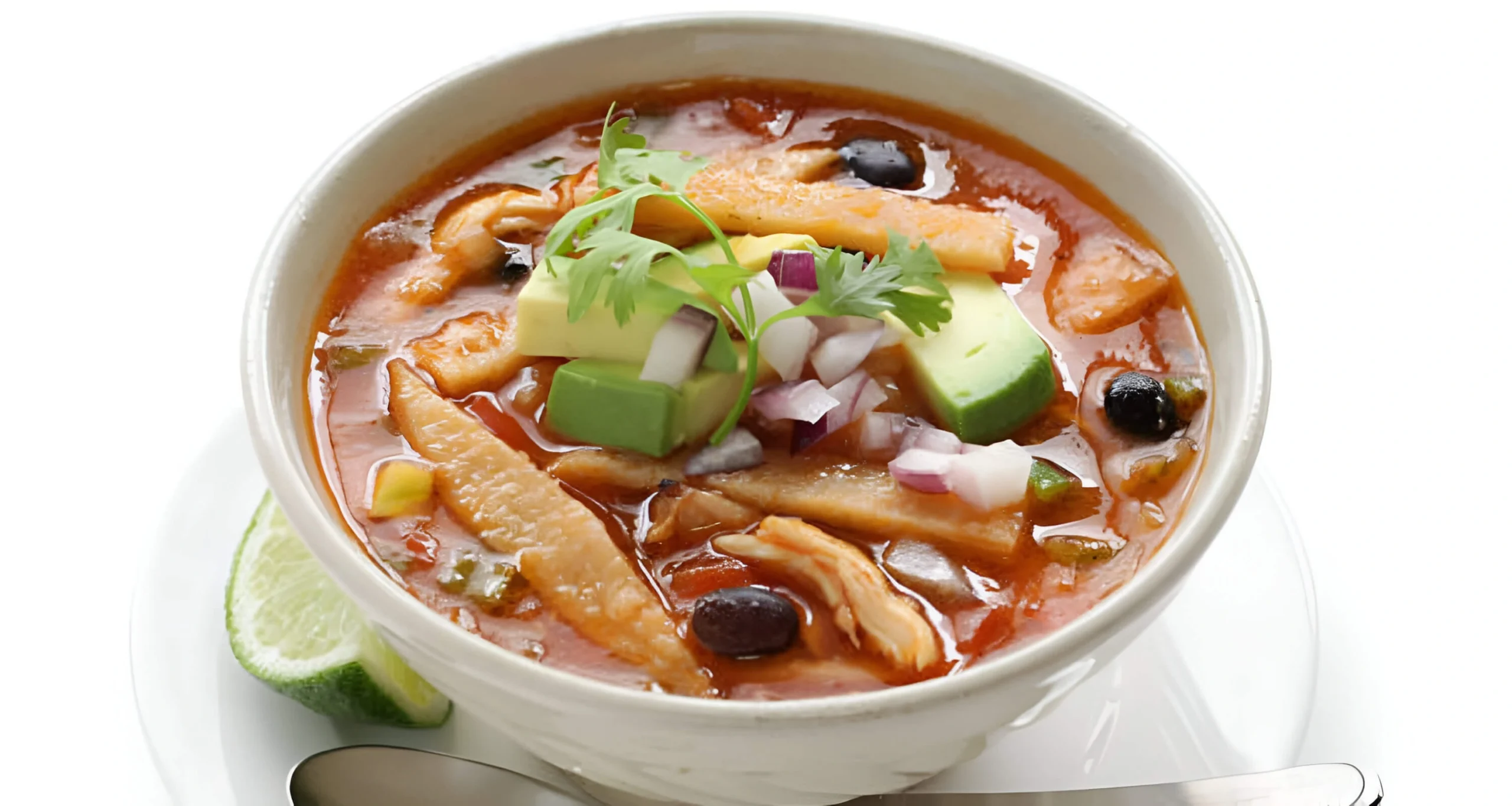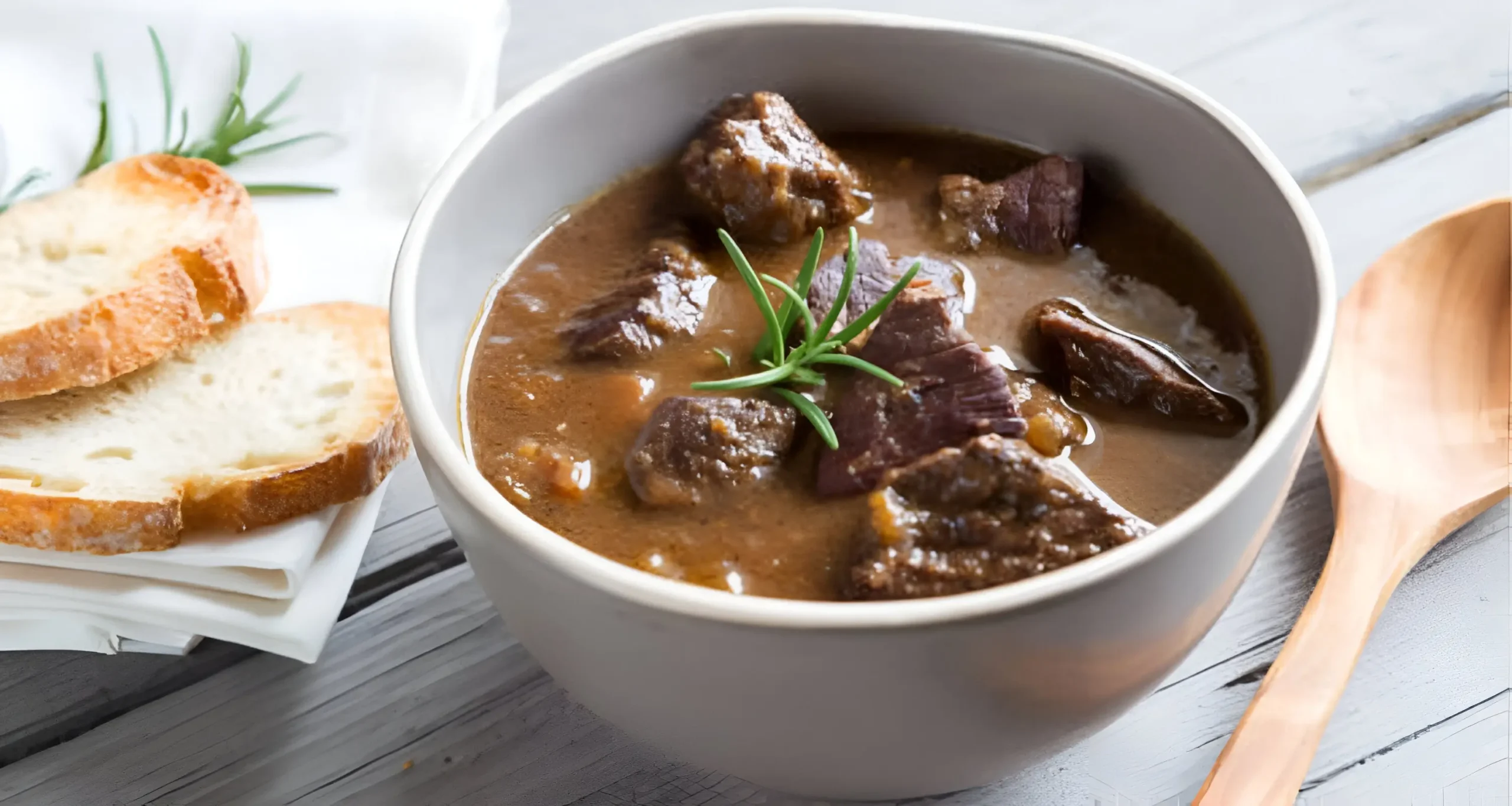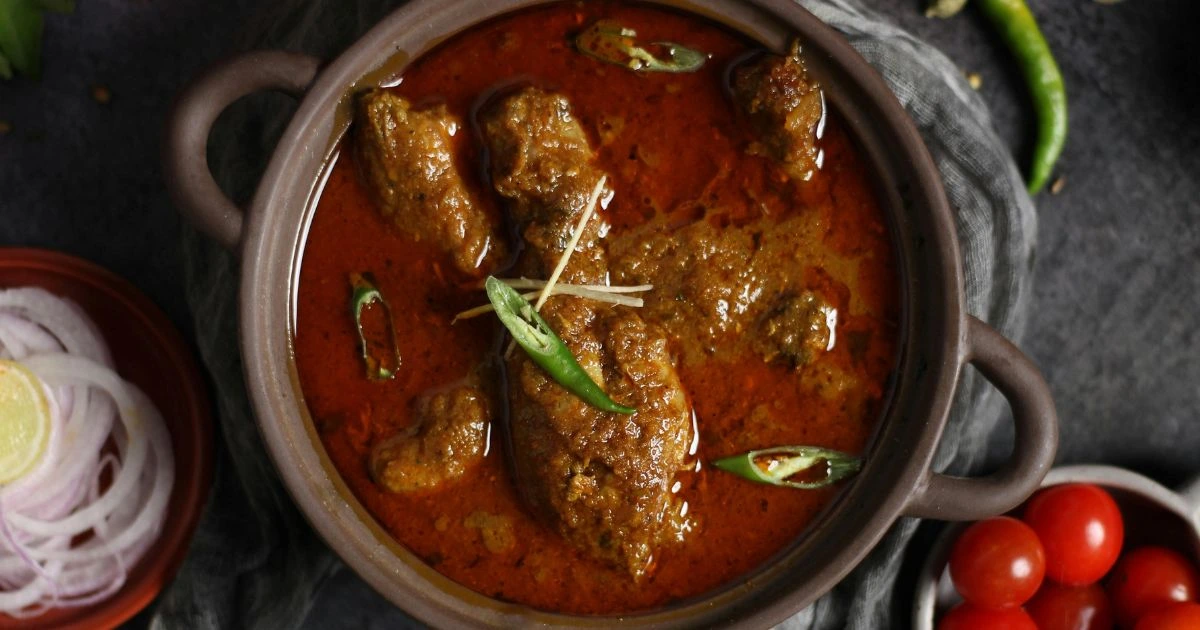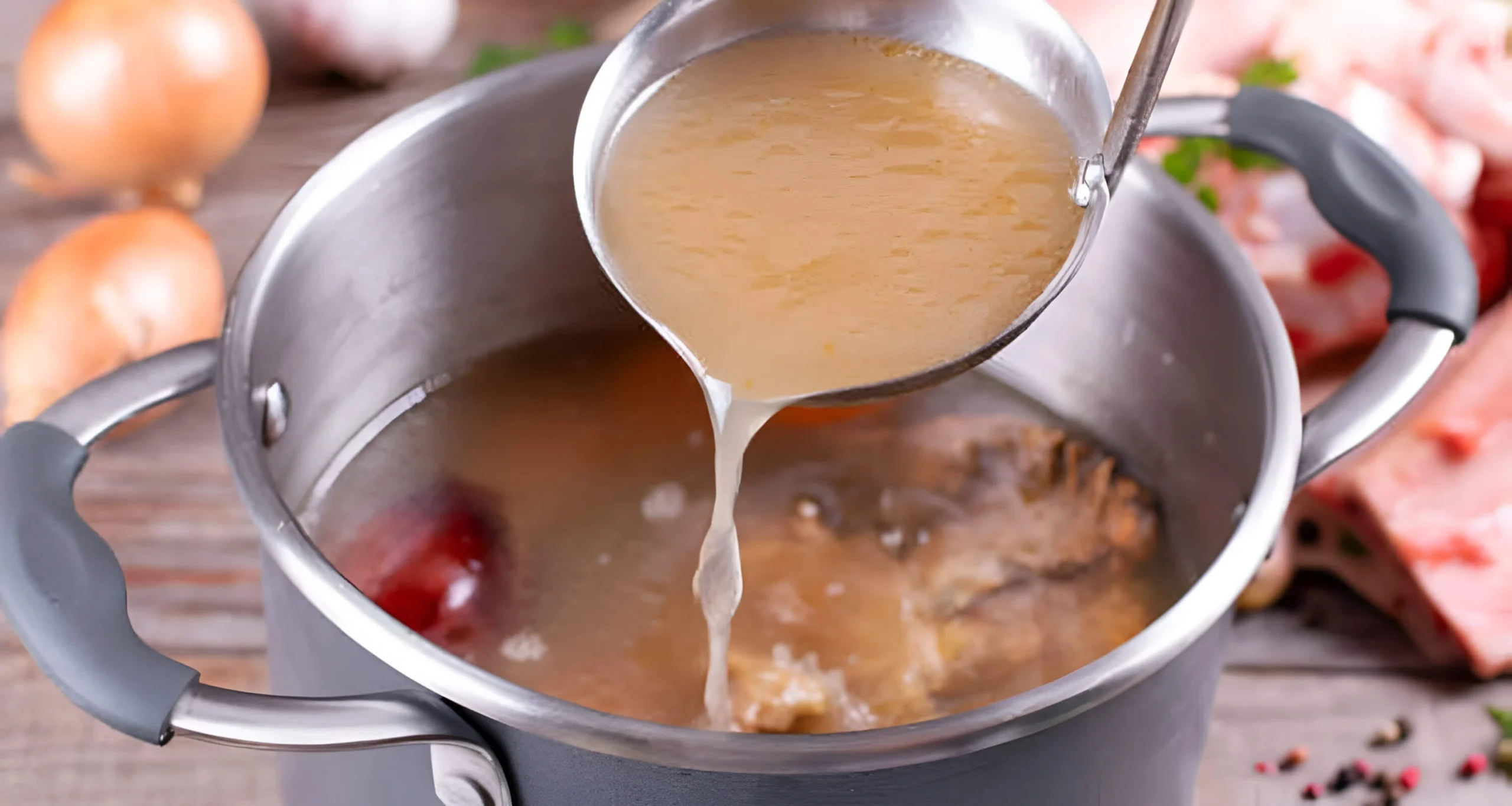How to Make Taiwanese Braised Beef Noodle Soup at Home
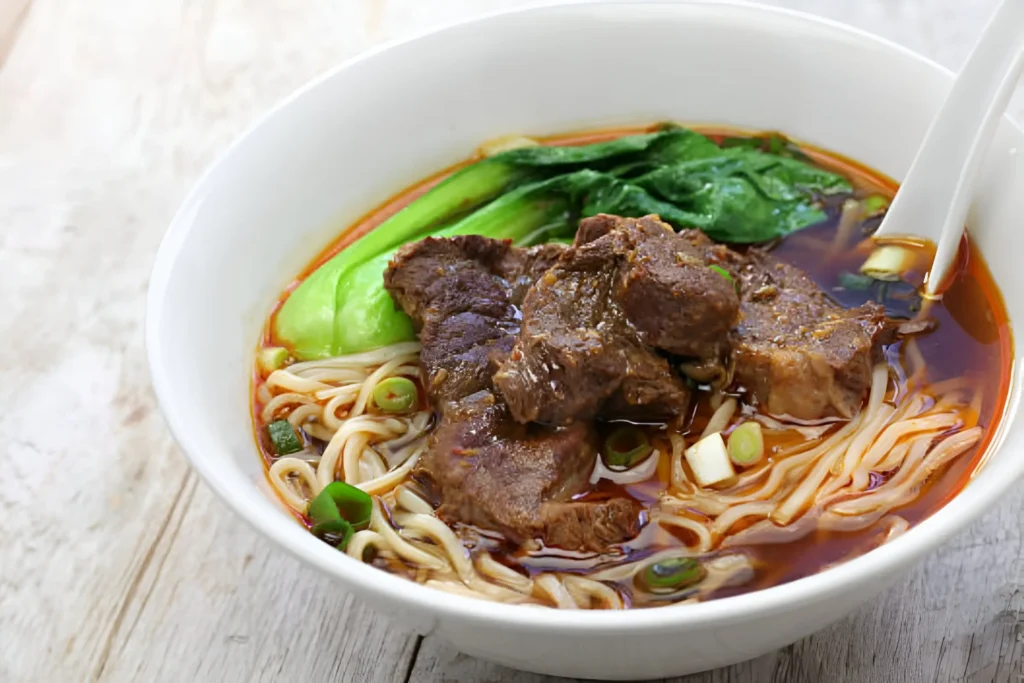
Introduction to Braised Beef Noodle Soup
When you think of Taiwanese cuisine, braised beef noodle soup immediately comes to mind. It’s a beloved dish that balances bold, savory flavors with tender textures, making it a comforting meal for any occasion. This dish is more than just a bowl of noodles; it’s a culinary masterpiece that represents the heart and soul of Taiwanese food culture. You’ll notice how the richness of beef, the aromatic broth, and the chewy noodles come together to create a harmonious dining experience.
To truly appreciate this dish, you need to understand its essential components. At its core, braised beef noodle soup consists of three major elements: a deeply flavorful broth, braised beef chunks, and perfectly cooked noodles. What sets this braised beef noodle soup apart is the use of classic Asian seasonings like soy sauce, star anise, and Chinese Shaoxing wine, which lend a signature depth of flavor. These ingredients, combined with slow cooking, create a savory base that’s both hearty and aromatic.
You’ll also find that this dish is highly versatile. In Taiwan, variations abound depending on the region or family recipe. Some versions have a spicier kick, while others lean toward sweeter undertones. Garnishes like chopped scallions, pickled mustard greens, and fresh cilantro elevate the bowl and customize it to suit your taste. Every layer of this soup tells a story of tradition and the artistry of slow cooking.
Whether you’re new to this dish or already a fan, mastering it at home allows you to bring a taste of Taiwan into your kitchen.
Why Braised Beef Noodle Soup is a Comfort Food Classic
When you take a spoonful of braised beef noodle soup, you immediately recognize why it has earned its status as a beloved comfort food. The braised beef noodle soup combines rich flavors, nourishing ingredients, and a heartfelt cooking process, making it a staple in Taiwanese households and beyond. Its deep cultural roots and emotional ties make it much more than just a meal—it’s an experience that comforts your body and soul.
The magic starts with the broth. Slowly simmered, it’s infused with bold aromatics like star anise, Sichuan peppercorns, ginger, and garlic. These spices release fragrant oils that fill the air and create a layered depth in the liquid. The savory, slightly tangy base made from beef shanks or short ribs, soy sauce, and Shaoxing wine is further enriched by its long cooking time, which tenderizes the beef while melding all the ingredients. The broth alone feels like a warm embrace on a chilly day.
The noodles are another reason you feel drawn to this dish. Whether you use thick wheat noodles or hand-pulled varieties, they act as the perfect vehicle for soaking up the flavorful broth. The chewy texture adds a satisfying bite that complements the tender chunks of braised beef. Every mouthful feels genuinely hearty, balancing protein and carbohydrates in a way that fuels you with comfort and energy.
Garnishes, too, play a key role in making the dish feel rich and comforting. Fresh scallions and cilantro add brightness, while pickled mustard greens bring a tangy contrast to the deep flavors of the braised beef noodle soup. A drizzle of chili oil or a sprinkle of white pepper can add warmth and spice, making the dish customizable to your mood and palate.
This combination of diverse textures, a slow-cooked process, and a harmony of spices creates a food experience deeply satisfying on every level. It’s the kind of dish that feels like home, wherever you enjoy it.
Essential Ingredients You’ll Need for Braised Beef Noodle Soup
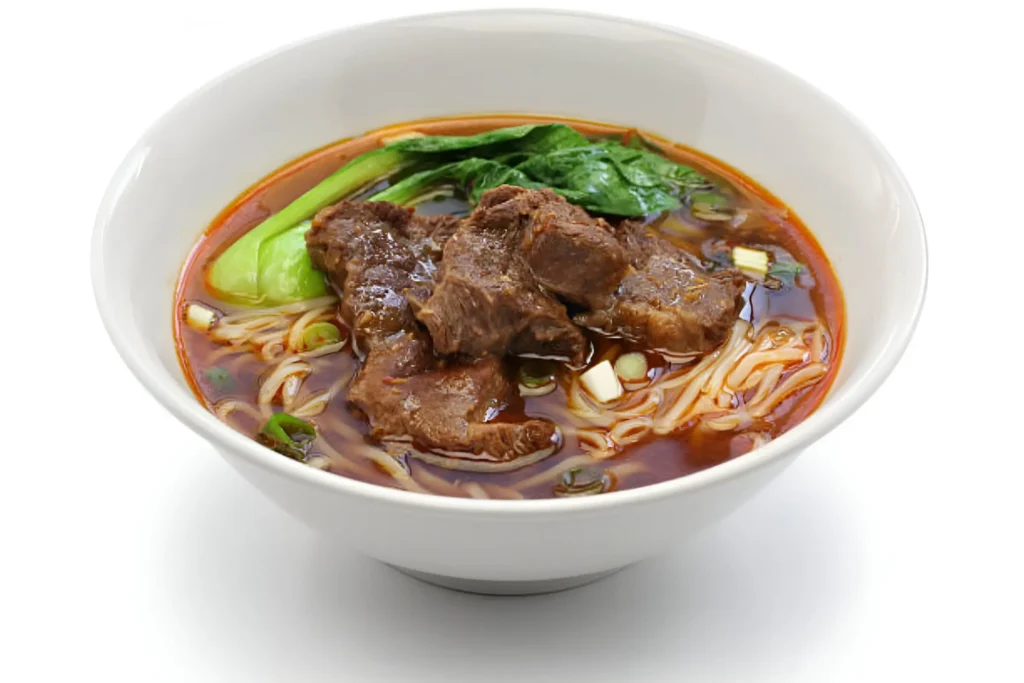
To create authentic Taiwanese braised beef noodle soup, you’ll need to stock your kitchen with a variety of ingredients that bring depth and richness to this comforting dish. From tender beef to aromatic spices, each element plays a crucial role in replicating the hearty flavors.
1. Beef
Choose a tough, collagen-rich cut like beef shank or brisket. These cuts break down during long braising, yielding tender, flavorful meat. For added depth, you can also include beef bones to enrich the broth.
2. Aromatics
The base of your braised beef noodle soup starts with ginger, garlic cloves, and scallions. These ingredients pack a punch of aroma, laying the foundation for the broth’s complexity.
3. Soy Sauce
You’ll need both light soy sauce for a savory touch and dark soy sauce to add a deeper color and slightly richer taste to the broth.
4. Spices
A blend of classic Chinese spices is essential. Key items include star anise, cloves, Sichuan peppercorns, cinnamon sticks, and bay leaves. These spices infuse the broth with warmth and depth.
5. Doubanjiang (Fermented Broad Bean Paste)
This spicy, umami-rich ingredient brings an authentic kick to your broth. Look for Sichuan-style doubanjiang for the best flavor.
6. Rice Wine
Shaoxing rice wine helps tenderize the beef and adds a subtle sweetness to the soup. It also balances the stronger flavors of the spices and soy sauces.
7. Beef or Chicken Stock
A high-quality stock serves as the backbone of your broth, ensuring a rich and satisfying base for your soup.
8. Noodles
Fresh wheat noodles are essential for a chewy, springy texture. If unavailable, dried noodles work as a substitute but won’t have the same bite.
9. Bok Choy
For a fresh, vibrant contrast to the hearty broth, bok choy or other leafy greens are a must. Blanch them separately before adding them to the soup.
10. Garnishes
Complete your dish with chopped cilantro, thinly sliced scallions, and a drizzle of chili oil. These add brightness and a final layer of flavor just before serving.
With these ingredients in hand, you’ll be set to recreate the bold, comforting bowl of braised beef noodle soup that is a hallmark of Taiwanese cuisine. Each component contributes to the perfect balance of flavors, textures, and aromas.
Selecting the Perfect Cut of Beef for Braising
Choosing the right cut of beef is essential to bringing out the rich, hearty flavors that make Taiwanese braised beef noodle soup so iconic. When selecting beef for braising, you want a cut that becomes more tender and flavorful as it cooks low and slow in the soup’s aromatic broth. Lean, tender cuts aren’t suitable for this dish because they tend to dry out and lack the marbling and connective tissue necessary for the desired melt-in-your-mouth texture.
Ideal Cuts for Braising
- Beef Shank This is one of the most traditional and widely used cuts for Taiwanese beef noodle soup. The shank comes from the animal’s leg, so it is filled with connective tissue and collagen that breaks down beautifully during braising. The results are tender slices of beef with a gelatinous quality that pairs perfectly with the broth.
- Chuck Roast or Chuck Ribs These cuts come from the shoulder area and are known for their marbling and rich flavor. Chuck is relatively inexpensive and becomes tender after simmering, making it a popular choice for many braised dishes. Look for pieces with even marbling and just enough fat for added flavor.
- Beef Short Ribs Short ribs are meaty and packed with flavor. The combination of fat and connective tissue in this cut ensures that the meat becomes soft and velvety after a long braise. Short ribs add a luxurious richness to the broth, but be mindful that they might require slightly more preparation and trimming.
- Brisket Another excellent option, brisket offers a deep, beefy flavor. Although it’s slightly leaner than shank or chuck, it still has enough connective tissue to achieve tenderness. Opt for the point cut rather than the flat for a bit more fat and moisture.
Tips for Selecting Quality Beef
- Look for marbling: Cuts with visible white streaks of fat throughout will have more flavor and tenderness after braising.
- Avoid overly lean cuts: Trimmed or dry cuts won’t yield the same decadence in texture.
- Talk to your butcher: They can recommend cuts that work best for slow-cooking and help you find the freshest, highest-quality meat.
By choosing the right cut and preparing it properly, you ensure that the beef in your Taiwanese noodle soup becomes a flavorful and tender centerpiece of the dish.
The Art of Preparing the Flavorful Broth
To create the heart of authentic Taiwanese braised beef noodle soup, you must master the broth. This step requires patience and attention to detail, but rewards you with a deeply comforting, aromatic base. Begin by selecting high-quality beef, preferably shank, short ribs, or brisket, as these cuts impart a robust flavor. Cut the beef into large chunks, ensuring even cooking and a hearty texture.
Start by blanching the beef to remove impurities. Boil water in a pot, add the beef for 2–3 minutes, then drain and rinse thoroughly. This step ensures the broth is clear and clean. Next, prepare your braised beef noodle soup aromatics. Gather ingredients like ginger, garlic, green onions, and shallots. Slice these into manageable pieces to fully release their flavors during cooking.
In a large stockpot, heat a small amount of oil over medium heat. Add the aromatics and stir-fry them until fragrant. Then, introduce key spices like star anise, Sichuan peppercorns, cinnamon sticks, and dried chiles, allowing the heat to awaken their oils and deepen their aroma. Afterward, stir in doubanjiang (fermented chili bean paste) for an umami kick, and cook briefly to incorporate its intense flavors.
Deglaze the pot with Shaoxing wine, which adds complexity, then pour in beef stock or water. Add soy sauce and rock sugar for depth and balance, and include a small piece of daikon for a subtle sweetness. Once all ingredients are combined, simmer the mixture gently for 2–3 hours, skimming the surface periodically. This will result in a broth that is rich, flavorful, and profoundly satisfying.
Step-by-Step Cooking Process for Perfectly Tender Beef
- Select the Right Cut of Beef Start by choosing the right cut of beef. For Taiwanese braised beef noodle soup , use beef shank or brisket, as both have rich marbling and connective tissue that produce tender, flavorful meat when slow-cooked.
- Prepare the Beef Cut the beef into large chunks, about 2 inches wide, to ensure they hold their shape during cooking. Rinse the pieces under cold running water to remove impurities and any residue from the butcher. Pat them dry using paper towels.
- Blanch the Beef In a pot of boiling water, blanch the beef pieces for 3–5 minutes. This removes excess blood and impurities that can cloud your broth. Skim off any foam that rises to the surface, then drain the beef and rinse it under warm water.
- Sear the Beef Heat a tablespoon of neutral oil, like vegetable or canola, in a heavy-bottomed pot or Dutch oven over medium-high heat. Sear the beef pieces on all sides until golden brown. This step develops a rich caramelized flavor, which will enhance the complexity of the broth.
- Build the Flavor Base In the same pot, sauté aromatics such as garlic, ginger, scallions, and shallots. Stir them for 1–2 minutes until they become fragrant. Add spices like star anise, Sichuan peppercorns, and a small cinnamon stick to the pot to build depth in the broth.
- Add Seasonings Incorporate soy sauce, rice wine, and a touch of rock sugar or brown sugar. Stir to combine and let the ingredients meld for 1–2 minutes before adding the beef back into the pot. Pour in enough beef stock or water to fully submerge the meat.
- Simmer Slowly Bring the pot to a gentle boil, then immediately lower the heat to maintain a slow, steady simmer. Cover the pot and allow the beef to cook for 1.5–2 hours. The slow simmering softens the connective tissue, resulting in tender meat.
- Check for Doneness After about 90 minutes, test the beef for tenderness by piercing it with a fork. It should yield easily but still hold its shape. If it isn’t tender enough, continue simmering and check every 15 minutes.
- Strain and Use the Broth Once the beef is done, carefully remove it from the pot using tongs. Strain the broth through a fine mesh sieve to remove the solids, leaving behind a clean, flavorful liquid. Reserve the beef and broth for assembly of your noodle soup.
The Secret to the Perfect Noodles for This Dish
To achieve the perfect bowl of Taiwanese braised beef noodle soup, your noodles need to strike a harmonious balance between texture, taste, and how well they soak up the broth’s rich flavors. Since the noodles form the backbone of this dish, choosing and preparing them correctly makes all the difference.
1. Choosing the Right Noodles
You’ll want to go for noodles that are firm yet bouncy to hold up against the hearty broth. Traditional hand-pulled wheat noodles are ideal because of their slightly chewy texture, which contrasts wonderfully with the tender beef. If you don’t have access to fresh hand-pulled noodles, look for dried or fresh Chinese-style wheat noodles at your local Asian market. As a backup, you can also use Japanese udon or even Italian linguine for a close match, but always prioritize noodles labeled for soup dishes.
2. Cooking the Noodles
Start by boiling a large pot of water with a pinch of salt. It’s important to cook the noodles separately from the broth to ensure they don’t release extra starch that could cloud or dilute the braised beef noodle soup. Follow the package instructions for cooking time but check frequently to avoid overcooking. You’re aiming for them to be just al dente, as they will soak up some broth during serving. Drain the noodles immediately and rinse them briefly under cold water to stop the cooking, then toss them with a drizzle of sesame oil to keep them from sticking together.
3. Noodle Texture Tips
For that authentic Taiwanese touch, slightly undercook the noodles if you plan to let them sit in a hot broth for longer. This way, the noodles finish cooking to perfection in the bowl without becoming mushy. Fresh noodles generally have a shorter cooking time, while dried ones may take slightly longer, so adjust accordingly.
4. Serving the Noodles
When assembling your dish, ladle the hot broth over the noodles just before serving. This ensures the noodles maintain their firmness while fully absorbing the broth’s bold flavors. Avoid leaving the noodles sitting in the broth for too long before eating, as this can cause them to absorb too much liquid and lose their texture.
By focusing on these details, your noodles will perfectly complement the depth and complexity of your Taiwanese beef noodle soup.
Tips for Balancing Flavors: Sweet, Savory, and Spicy
Crafting the perfect Taiwanese braised beef noodle soup requires an understanding of flavor balance to create a harmonious dish. Taiwanese cuisine often shines because of its ability to blend sweet, savory, and spicy flavors seamlessly. Here’s how you can ensure every bite of your soup is perfectly balanced.
1. Sweetness
To introduce sweetness, you’ll often rely on ingredients like rock sugar, a common component in Taiwanese cooking. Add it sparingly, as it’s meant to enhance other flavors, not overpower them. If you don’t have rock sugar, brown sugar or even a small piece of honeycomb can be used. Aim to taste as you go—start with less and gradually adjust, ensuring it complements the richness of the beef.
2. Savory Depth
The savory profile of braised beef noodle soup should come from layering umami-rich components. Soy sauce (both light and dark varieties) is essential for achieving depth and color. For added complexity, use fermented bean pastes such as doubanjiang, which not only contribute saltiness but also a slight tanginess. Incorporate aromatics like shallots, garlic, and ginger early in the cooking process to infuse the broth with a foundation of savory notes.
3. Spiciness
Spicy elements in the soup are traditionally subtle but present. Use dried chili peppers, Sichuan peppercorns, or a small spoonful of chili oil. For a bolder kick, freshly sliced red chilies can be added as a topping right before serving. Remember, spice levels are entirely adjustable—find a balance that works for you and your guests.
Tips for Integration
- Taste Continuously: Create layers of flavor by tasting your broth at each stage of cooking. This ensures no single flavor dominates.
- Let It Rest: Allowing the braised beef noodle soup to simmer for longer can meld the flavors together beautifully.
- Condiments: Serve the soup with optional toppings like pickled mustard greens or extra chili oil. This lets each diner adjust the final flavor to their liking.
By focusing on these elements, you’ll have a deliciously balanced Taiwanese beef noodle soup that’s rich, flavorful, and unforgettable.
Serving Suggestions and Toppings to Enhance Your braised beef noodle soup

When it comes to elevating your Taiwanese braised beef noodle soup , the toppings, accompaniments, and presentation play a crucial role. To create a well-rounded dining experience, focus on both visual appeal and complementary textures. Start by garnishing the braised beef noodle soup with fresh herbs and vibrant toppings that add bursts of color and flavor.
Essential Toppings
- Chopped scallions: Sprinkle chopped scallions over the bowl for a fresh, mildly oniony aroma and a pop of green.
- Cilantro leaves: A handful of cilantro enhances the soup with an earthy and citrusy note.
- Pickled mustard greens (suan cai): This traditional Taiwanese topping provides tanginess and crunch, balancing the richness of the broth.
- Chili oil or chili flakes: Add a drizzle of chili oil or a pinch of chili flakes if you prefer a spicy kick to cut through the deep beef flavors.
- Toasted sesame seeds: Scatter toasted sesame seeds for an added nutty aroma and subtle crunch.
Adding Texture and Complexity
- Soft-boiled eggs: Slice a soy-marinated egg in half and nestle it atop the noodle soup for creamy texture and umami.
- Crispy shallots or garlic chips: Sprinkle over fried shallots or garlic for a crispy, savory contrast.
- Blanched greens: Include bok choy, mustard greens, or spinach to introduce a fresh, slightly bitter element that pairs beautifully with the hearty broth.
Perfect Pairings
Serve your braised beef noodle soup alongside steamed or fried dumplings for a hearty meal. A plate of Taiwanese-style cucumber salad or a side of tangy pickles can provide light, refreshing contrast to the warm, robust soup. You might also include a pot of oolong tea to complete the authentic Taiwanese experience.
Common Mistakes to Avoid in Braised Beef Noodle Soup
When making braised beef noodle soup, some common mistakes can impact the flavor, texture, and authenticity of your dish. Avoiding these missteps will help you create a bowl that’s rich, balanced, and reminiscent of the traditional Taiwanese favorite.
1. Using the Wrong Cut of Beef
- Choosing a lean cut like tenderloin or sirloin can result in dry, tough meat. Instead, opt for shank, chuck, or brisket—cuts with ample marbling and connective tissues. These are ideal for braising and develop a melt-in-your-mouth texture after slow cooking.
2. Skipping the Step of Browning the Beef
- Skipping this step may seem like a shortcut but compromises on flavor. Browning caramelizes the surface of the meat, creating depth and richness that enhances the soup. Always sear your beef chunks over medium-high heat before braising.
3. Overlooking the Importance of Toasting Spices
- Adding raw spices directly to the broth can lead to muted flavors. Toasting spices like star anise, Sichuan peppercorns, and cinnamon in oil releases their essential oils, making the final broth more aromatic and authentic.
4. Neglecting to Skim the Fat and Scum
- If you neglect to skim the surface of the broth, your braised beef noodle soup may turn greasy and develop an unpleasant aftertaste. Regularly remove excess fat and scum during the braising process to ensure a clean, clear broth.
5. Imbalancing the Flavor Profiles
- Failing to maintain balance between the salty, sweet, and umami elements can result in a broth that’s either too bland or overpowering. Use soy sauce, sugar, and fermented broad bean paste judiciously, and adjust seasoning as the soup simmers.
6. Cooking the Noodles Too Soon
- Cooking the noodles and leaving them in the soup can make them soggy. Always cook noodles separately and add them to the bowl just before serving. This keeps their texture chewy and prevents them from absorbing too much broth.
7. Forgetting Fresh Garnishes
- Forgetting to use fresh garnishes like cilantro, scallions, and pickled mustard greens can leave your soup feeling incomplete. These ingredients provide a refreshing contrast to the rich broth and make the dish truly authentic.
Paying attention to these details ensures that every bowl of your Taiwanese braised beef noodle soup is an enjoyable and authentic experience.
Make It Your Own: Creative Variations and Substitutions
When making Taiwanese braised beef noodle soup, you have plenty of opportunities to adapt the recipe to your taste or accommodate dietary preferences. By tweaking ingredients or trying fun alternatives, you can create a version that’s truly your own. Here’s how you can get creative.
Noodles and Bases
- Change up the noodles: While traditionally made with chewy wheat noodles, you can substitute with rice noodles for a gluten-free option, udon for a thicker texture, or even spaghetti if that’s what you have on hand.
- Alternative broths: If beef isn’t your preference, chicken or vegetable broths can act as a lighter base while still holding onto the bold flavors of the seasoning mix.
Proteins
- Swap the beef: Pork, chicken thighs, or even tofu can replace the traditional beef shank. Braised short ribs or oxtail make decadent alternatives too.
- Vegetarian-friendly protein: Add plant-based proteins like seitan or tempeh. You can also increase the amount of mushrooms or use jackfruit for a meatier texture.
Flavor Additions
- Play with spices: Try star anise, cinnamon, and cardamom for a more spiced profile, or add chili oil if you want additional kick.
- Layer in fermented goodness: Doubanjiang (fermented chili bean paste) adds depth, while miso paste introduces a unique umami note.
Veggies and Garnishes
- Creative vegetables: Swap bok choy with spinach, kale, or napa cabbage. Root vegetables like daikon or carrots are great additions as well.
- Custom garnishes: Go beyond the usual cilantro and green onions. Try pickled radish, fresh herbs like Thai basil, or even a squeeze of lime for a tangy twist.
With endless customization options, you can make this beloved dish as close to—or far from—the traditional recipe as you’d like. Keep experimenting until it becomes your signature!
Storage and Reheating Tips for Maximum Freshness
Storing and reheating your Taiwanese braised beef noodle soup properly is essential to maintain its rich flavors and ensure the texture of the ingredients remains just right. Follow these tips to keep your leftovers fresh and delicious.
Storing the braised beef noodle soup
- Separate the Broth and Noodles: Before storing, always separate the noodles from the broth to avoid the noodles soaking up too much liquid and becoming overly soft. Use airtight containers for both the broth and the noodles.
- Cool the Soup Before Refrigerating: Allow the broth to cool to room temperature before placing it in the refrigerator. This helps prevent condensation and ensures the soup remains fresh longer.
- Refrigeration: Store the broth and noodles separately in the fridge if you plan to eat the leftovers within 3 days. Place any leftover toppings, such as vegetables or beef, in a separate container to preserve their texture.
- Freezing: For longer storage, freeze the broth in a freezer-safe container, leaving a bit of room at the top to account for expansion. Avoid freezing the noodles, as they don’t hold up well when thawed.
Reheating the braised beef noodle soup
- Reheat the Broth Separately: Heat the broth in a pot over medium heat until it’s steaming and piping hot. Stir occasionally to ensure even heating.
- Warm the Noodles: If the noodles were refrigerated, warm them by placing them in a bowl and pouring some boiling water over them. Let them sit for a minute or two, then drain well.
- Combine and Heat Gently: Once the broth is hot, pour it over the noodles and toppings in a bowl. You can give the entire dish a gentle warm-up in the pot, but avoid boiling the noodles to prevent them from turning mushy.
- Optional Adjustments: Taste the braised beef noodle soup after reheating and adjust the seasoning if needed. You can add a splash of fresh soy sauce, vinegar, or chili oil for enhanced flavor.
Taking these steps will help you enjoy the full flavor and texture of your Taiwanese braised beef noodle soup even after storing it.
Why Homemade Braised Beef Noodle Soup is Worth It
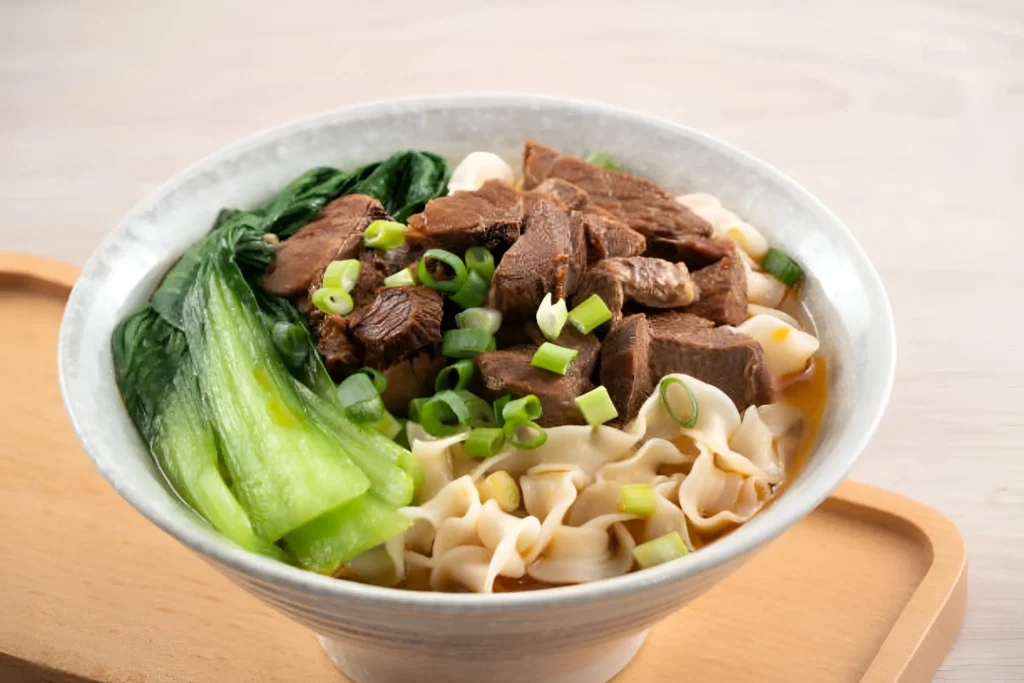
Making homemade braised beef noodle soup is a rewarding process that allows you to truly appreciate the depth and complexity of this beloved Taiwanese dish. When you prepare it yourself, you can control every aspect of the meal, which means a tailored flavor profile that perfectly suits your palate. This is something store-bought or restaurant versions cannot easily offer.
The foundation of the dish lies in its aromatic beef broth, a rich combination of soy sauce, spices, and umami-packed ingredients. When you make it at home, you can experiment with the balance of flavors. For example, you can adjust the saltiness, sweetness, spice level, and even add unique ingredients such as Chinese cooking wine or fresh ginger to customize your broth. You can also use higher-quality beef cuts that impart better flavor and texture, ensuring each bowl is crafted to your liking.
Another advantage of the homemade approach is the authenticity it brings to your kitchen. Many pre-packaged noodle soups lack the traditional herbs and spices, like star anise or Sichuan peppercorns, that give Taiwanese braised beef noodle soup its defining character. Learning how to work with these ingredients not only enhances your cooking skills but deepens your understanding of Taiwanese cuisine.
There’s also the undeniable satisfaction that comes from creating a dish from scratch. From braising the beef to perfectly seasoning the broth and cooking the chewy wheat noodles, each step is an opportunity to bond with the process and marvel at the transformation of simple ingredients. Plus, you’ll avoid the preservatives and artificial flavors often found in ready-made versions.
Homemade braised beef noodle soup lets you prepare extra portions to freeze, giving you ready-to-eat meals for busy days. Unlike takeout, where portions and quality can be inconsistent, making it at home ensures freshness and lasting value.
Frequently Asked Questions About Braised Beef Noodle Soup
1. What cut of beef is best for braised beef noodle soup?
You should use cuts of beef that are flavorful and can withstand long, slow cooking methods. Shank, brisket, chuck, or short ribs are all excellent options. These cuts contain connective tissue that breaks down to create a tender, juicy texture and enriches the broth with a hearty flavor.
2. Can you make it spicy?
Yes, you can adjust the spice level to your taste. Adding chili bean paste (doubanjiang) or dried red chilies to the braising liquid will give the soup a spicy kick. If you prefer a milder flavor, you can reduce or omit those ingredients. Garnishing with chili oil at the end allows you to give individual servings some heat without affecting the entire batch.
3. Do I have to use fresh noodles?
Fresh noodles are preferred for their chewiness and authentic texture, but dried noodles can also work if fresh ones aren’t readily available. Look for Asian-style wheat noodles as a substitute. Cook them according to the package instructions before adding them to the soup to avoid sogginess.
4. How long should you braise the beef?
You should braise the beef for at least 90 minutes, but 2–3 hours is ideal to achieve maximum tenderness. The longer braising time allows the connective tissue to melt into the broth, enhancing both the meat’s texture and the soup’s richness.
5. Can I make it ahead of time?
Yes, this braised beef noodle soup is a great make-ahead dish. In fact, the flavors often deepen and improve overnight. Store the braised beef noodle soup and noodles separately to maintain the noodles’ texture. Reheat the broth with the beef, and add freshly cooked or reheated noodles just before serving.
6. Is there a vegetarian version?
You can create a vegetarian alternative by substituting the beef with tofu or mushrooms and using vegetable broth as the base. Include umami-enhancing ingredients such as miso paste or dried shiitake mushrooms to achieve a depth of flavor similar to the traditional version.
Final Thoughts and Encouragement to Try the Recipe
Making authentic Taiwanese braised beef noodle soup at home might seem like a challenge initially, but it’s absolutely worth the effort. You don’t just create a dish—you’re crafting a bowl of rich culture, tradition, and comfort with every stirring of the pot. The beauty lies in how customizable it is; with your choice of noodles, toppings, and the unique tweaks you bring to the broth, it becomes a dish that reflects your taste and personality.
If you’ve never experienced the depth of flavors in this iconic Taiwanese dish, this is your opportunity to bring it to life. The combination of tender beef, fragrant star anise, and the slow simmering process allows the flavors to meld together, creating a harmony that will instantly transport you to the bustling streets of Taipei. This recipe also lets you control every ingredient, ensuring a healthier and cleaner version than many restaurant alternatives.
If you’re worried about how much time it takes, think of it as time well-spent. Much of the process is hands-off, and the aroma that fills your kitchen while the broth simmers is incredibly rewarding. Plus, once you’ve mastered this recipe, it’s easy to adjust and make it a staple in your home.
So go ahead—gather your ingredients, take your time, and trust the process. You don’t need to be a professional chef to create something truly special. With this recipe in your hands, you’re fully capable of enjoying an authentic Taiwanese classic right in your own kitchen. You’ve got this!
Add a Dash of Your Thoughts!
There are no reviews yet. Be the first one to write one.

